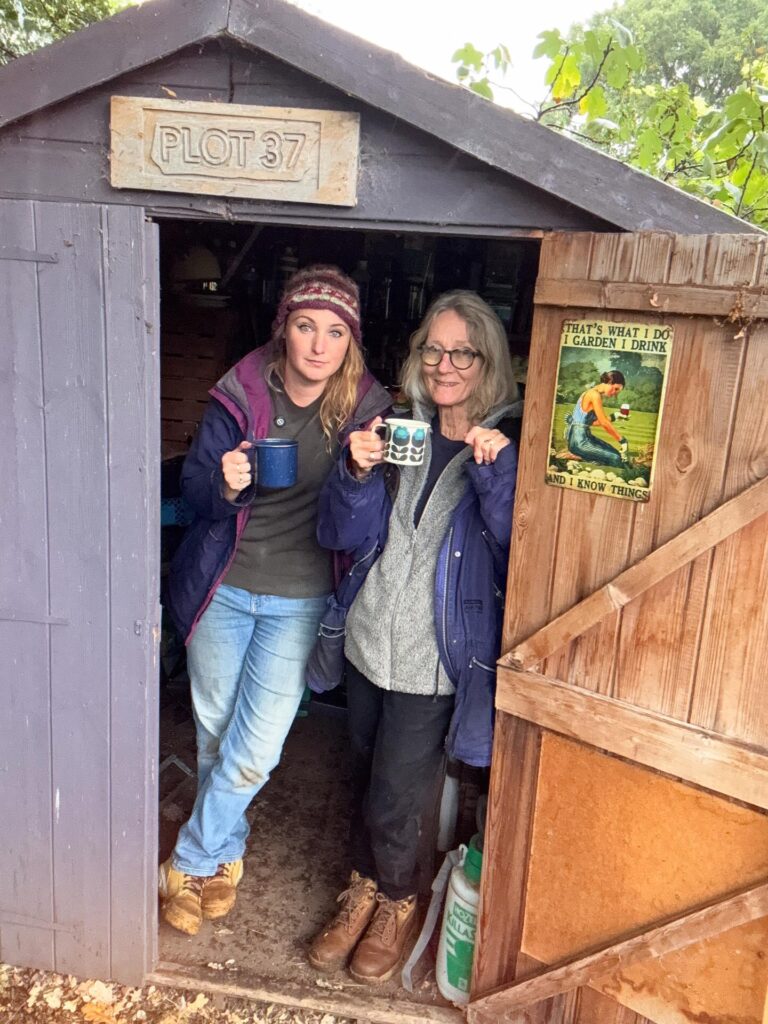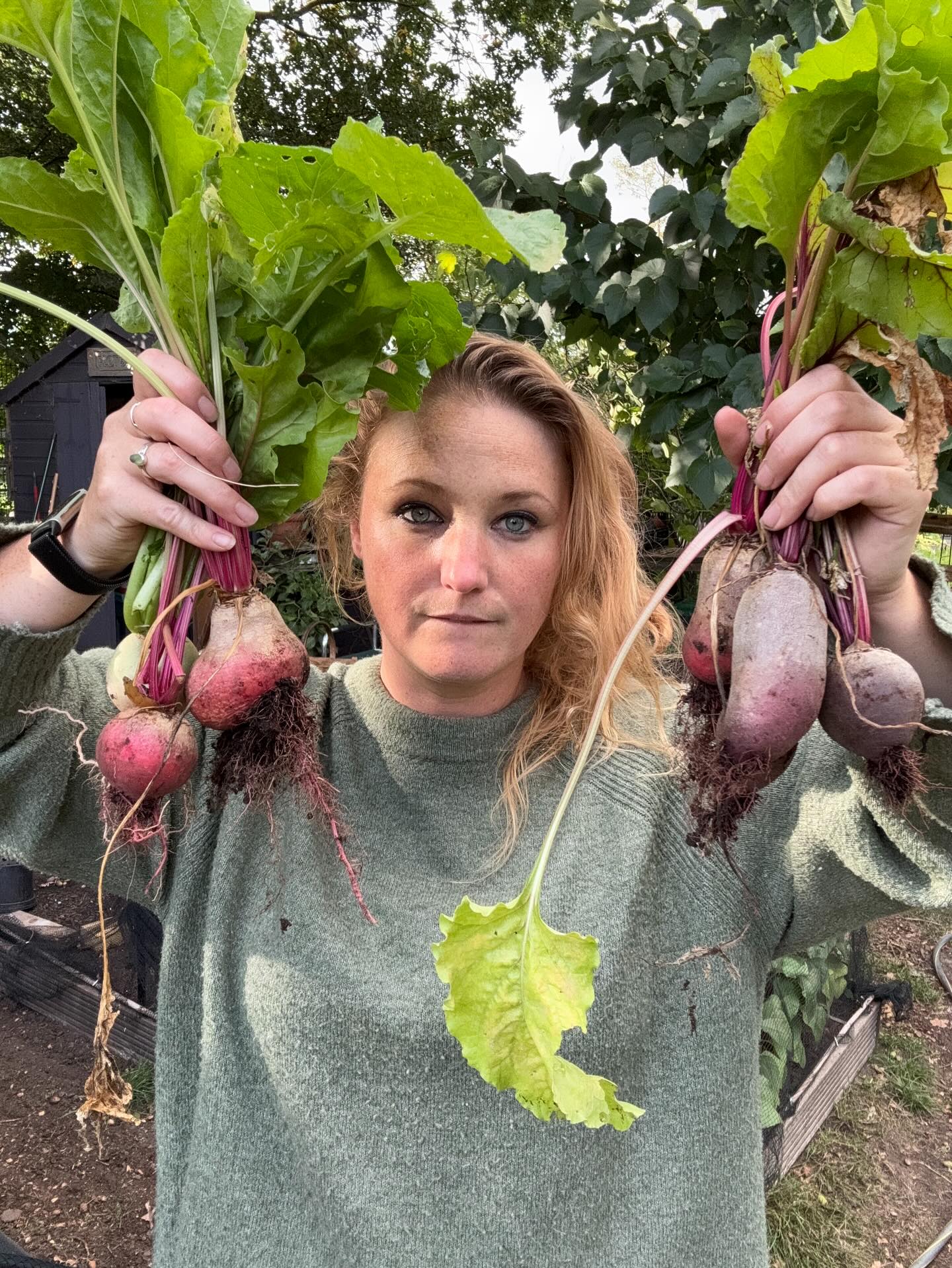Autumn is a gentle pivot in the gardening year when the light softens, the soil still holds a little warmth, and next spring’s promise starts with quiet, practical jobs rather than grand gestures. It’s the moment to clear tired foliage, mulch the beds, tuck bulbs and bare-root plants into welcoming ground, and sketch the rotations that will carry us into a new season. With that spirit, Grown Local is launching “Behind the Gardener”—unhurried conversations with growers who mix practicality, personality, and real-world plots to help us keep learning when the days draw in.
First up is Jessie Sheffield of Plot 37, a London allotment vlogger whose week-by-week videos chart sowing, setbacks, and seasonal wins in a way that feels like a chat over the shed door.
Welcome to “Behind the Gardener”.
Meet Jessie: The Heart Behind Plot 37
Jessie Sheffield is a vlogger, a very keen vegetable grower, an artist, and an ex-proper gardener. She tends a 14-rod allotment in south-west London that has become the heart of both her work and her week. Her path has meandered between gardening and art over the years. When lockdown hit and her job as a casting technician disappeared, she turned to the allotment that same week and started a YouTube channel. It began as a way to document what she was sowing, tending, tasting, and learning.
Five years on, that rhythm endures: a new video every Tuesday, recipes and harvest notes shared throughout the week on Instagram, and a steady sense —that this is gardening as it truly happens, not as a glossy magazine might have it.
These days, Jessie gardens almost entirely with her mum, and that partnership has shaped both the pace and the purpose of Plot 37. She’s stepped away from her former life tending immaculate West London gardens, and the shared allotment is now her focus—which suits her just fine. “I’m a vegetable grower at heart,” she says. It was always a struggle trying to encourage the Ladies Who Lunch of Chelsea and Kensington that they really should have something productive in their immaculate gardens. They weren’t keen. But on Plot 37 there’s no need to persuade anyone—the beds are full of food that tastes of the season and the soil, grown by two people who know what they like to eat and how they like to spend their time.

Potato Passion: Jessie’s Tried-and-True Varieties
The potatoes were fantastic this year, despite the blooming heat and dryness. Jessie always grows Red Duke of York as her first early—she trusts its flavour and reliability, and loves how the bright red skins split slightly when fried so they go extra crispy. This year, she returned to an old favourite—Kerr’s Pink—as her main crop: a pretty shell-pink potato with a flattened shape that makes phenomenal jacket potatoes.
She also added two lesser-known Scottish varieties to the mix: Caledonian Pearl and Caledonian Rose. Pearl—a white, thin-skinned, creamy little gem—was one she’d grown once before and was thrilled to find again at Grown Local. Rose was a wild card: gorgeous bright pink, almost fuchsia, with a yellow interior. Both turned out to be outstanding.
Next season, she plans to grow the same four: two first earlies, two main crops, spanning shades from white to pink. Still, she admits there’s always room for one more experiment—maybe a waxy little Ratte or Pink Fir Apple—when the chitting boxes come out.
Chitting with Intention: Jessie’s February Ritual
Jessie’s method is unhurried and rooted in ritual. She’s a committed chitter—despite knowing that many say it makes little difference, especially for maincrops, it’s a tradition she cherishes. Each February, she sets her seed potatoes out in egg boxes, a quiet act of preparation during a time when there’s little else to do. She aims to get the first batch in the ground around St Patrick’s Day, with the main crops following a month or six weeks later.
They used to grow their potatoes in pots but have returned to planting straight in the ground, finding the yield far superior. Jessie puts this down to watering and feeding. “In pots they’re entirely at our mercy,” she says, “and I won’t lie, we aren’t the best at consistent pot-watering.”
In open ground, the plants can fend for themselves, sending roots deeper to find moisture and nutrients through the well-rotted horse manure mulched in before planting—the kind of slow, foundational feeding that builds soil over time.
Jessie has always documented the real side of gardening—setbacks and all—through her vlogs and Instagram posts. “It seems ridiculously disingenuous to only show the highs,” she says, “when what makes someone a gardener is often that resilience in the face of a slug attack.”
This year, they miraculously escaped blight on both potatoes and tomatoes—a rare thing. They do get scab on the potatoes, but Jessie doesn’t mind: “As long as it’s not eaten deep into the tuber, the textured skins are just that bit crispier when stuck in the oven covered in goose fat.” They rotate crops and cover everything in netting, but there’s only so much you can do. Sometimes you just have to go with it, and that acceptance is part of what keeps the work sustainable year after year.
Tomato Triumphs: 24 Varieties and a Few Surprises
In a season full of surprises, the tomatoes were a standout success. Jessie grew a “very reserved” 24 varieties—the fewest she’s done in a long time—and still discovered some real gems. Orange Wellington was a complete star: thick, heavy fruit so orange they looked like persimmons, with few seeds and deep flavour. Skykomish was another new one that impressed. Sgt Pepper, which did nothing last year, stood out this year. Same with Black Rebel Starfighter Prime—proof that sometimes a variety just needs the right season to show what it can do.
Old favourites Black Krim and Japanese Black Trifele both delivered that smoky, rich flavour she values in a good dark tomato. Chocolate Cherry and Green Doctor were disappointing, and the usual bajillions of Sungold were fairly tame. But overall? What a year for tomatoes.
Fruits, Herbs & Unexpected Wins
Beyond potatoes and tomatoes, it was an outstanding year for fruit in general. Gooseberries, loganberries, grapes, figs, pears, apples, plums, quinces, currants, and cherries all flourished—the kind of harvest that fills the freezer and still leaves armfuls to share.
Jessie also finally got to grips with coriander, a crop she’d always struggled with. The basil was incredible too, especially the Lettuce Leaf giant, with leaves big enough to wrap around things. And mizuna—she hadn’t quite understood the hype until this year when its peppery freshness kept giving well into the cooler months.
Failing Gracefully: Lessons from the Bean Bed
Of course, not everything went to plan. After last year’s bumper bean crop, when they were taking bundles down to the pub every night, this year they got a handful at most. It was too hot, too dry; animals dug them up, and what survived was hit by aphids, black spot, and poor fertilisation. Total disaster.
But the lesson? “Some years are the year of the tomato and others are the year of the bean,” Jessie says. “And if it was the same every year, it would get boring.”
There’s a freedom in that acknowledgment: the garden is a partner, not a project to be controlled. Resilience, she believes, comes not from never failing but from failing gracefully—and starting again.
From Plot to Show: Jessie’s Hampton Court Adventure
This year also brought something entirely different: a show garden at Hampton Court. Jessie had never had to grow things to be ready at a set time before, and with such a hot summer, everything was bolting. She reckons she sowed six rounds of mizuna and it was still flowering in the show.
Beyond the horticultural gymnastics, the real challenge was logistics and people management—learning how shows actually work, navigating endless risk assessments, and bringing together a group of strangers and hoping they’d gel. Fortunately, they had a fantastic bunch.
Would she like to take on Chelsea or another big show? “Er, no. Not any time soon.” The Hampton Court project took eight months of work on a shoestring budget raised via Crowdfunder, and stepping up to Chelsea would be a whole different ballgame—for pressure, money, and rules. Plus, you can’t even grow your own plants for the show gardens, which rather takes the shine off for a hands-in-the-soil plotter.
Autumn Prep: Sowing Hope for Spring
Back on the allotment, what helps Jessie keep going through autumn and winter when many gardeners lose momentum? She’s not usually one to struggle—she finds the slow slide into autumn quite beautiful, though this year it happened so suddenly. Still, she’s sowing, and that helps. “There’s something about putting seeds into compost that keeps hope alive even when the light is fading.”
She’s also getting geared up for the Great Winter Jobs List, which she always finds exciting. “If you think of this time of year as prep for next spring rather than the end of summer, it softens the blow,” she says. That perspective shift turns autumn from an ending into a beginning.
Beyond the Beds: Jessie’s Creative Life
When she’s not gardening, Jessie makes sculpture, mainly in ceramics, at a shared making space five minutes from her house. She hasn’t shown up in a while, but that’s something she’s keen to get back into.
Since starting her YouTube channel, she’s had to learn to intentionally ‘go for a walk’—half her time is now spent editing and managing the online side of things. Living on the edge of Richmond Park, she’s out shuffling through bracken a lot these days, with no destination beyond moving her body and letting her mind settle.
And when the tools are down? For Jessie, it’s always a pint of cider. “I drink wine at home but always cider when I’m out. I like it fresh but fairly dry, not too sweaty-socks.” Most pubs serve Aspalls, which she’ll drink, but she much prefers the Fullers Cornish Orchard, or Orchard Thieves.
It’s the kind of simple pleasure that ties the week together: soil under your nails in the morning, cider in your hand in the evening, and the quiet satisfaction of having done the work well.
Follow Jessie
You can find Jessie on her YouTube channel, Jessie at Plot 37, or on Instagram as @Plot_37. She posts a vlog every Tuesday afternoon, along with recipes and harvest updates throughout the week and you can see what she’s sowing and growing from Grown Local here. Her content offers steady company for autumn and beyond—gardening that’s real, generous, and grounded in the joy of growing and sharing, setbacks and all.

